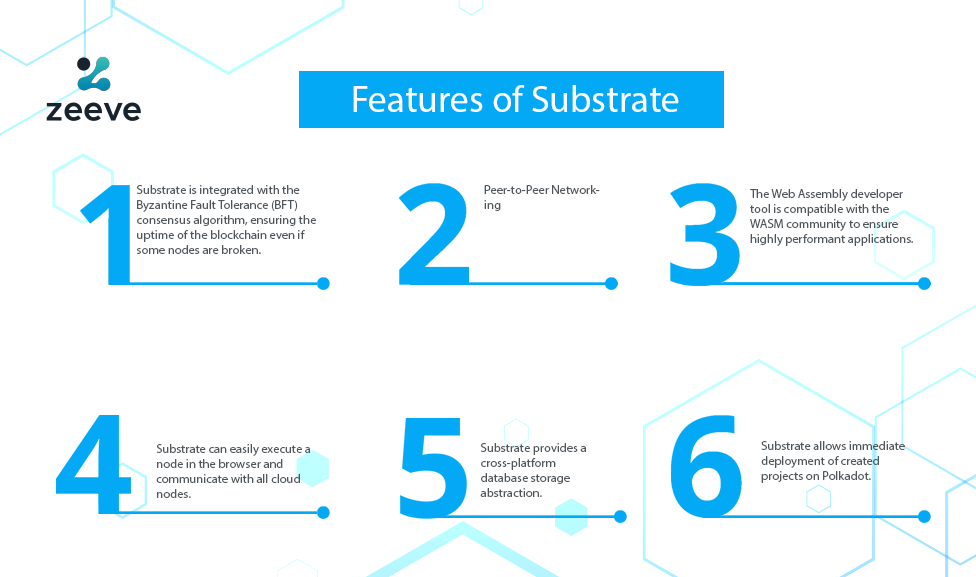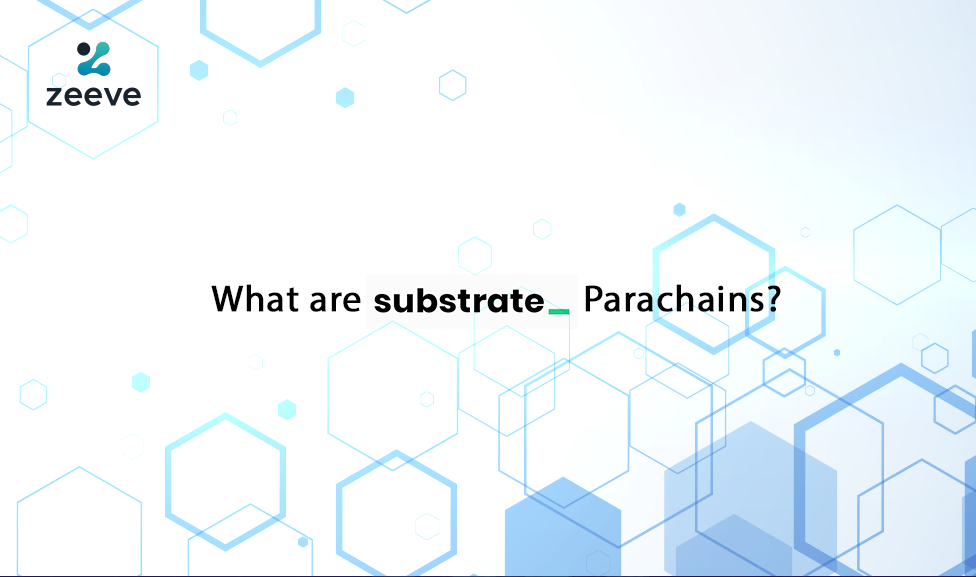Polkadot is an open-source project that integrates a growing ecosystem of unique blockchains called parachains. It enables cross-blockchain transfers of any data, forming the foundation of an interoperable decentralized web. Polkadot is an environment-friendly blockchain that consumes a small bit of the energy used by traditional blockchains.
Polkadot allows the creation of a custom blockchain using the Substrate framework. The substrate framework helps to create blockchain networks on the Polkadot blockchain. However, it doesn’t imply Substrate is only used for Polkadot; you can also use it to design independent blockchains.
Polkadot is a network of networks where the connected chains are known as Parachains. Parachains create an extensive web of chains that share the same security and are coordinated correctly. To efficiently build blockchains, the developers have put all the functionalities into a Substrate framework. In the article below, we will explore these foundations of Web3 – Substrate and Parachains.
What is a Parachain?
Parachain is the backbone of the Polkadot blockchain as they are custom, project-specific blockchains running parallel to the relay chain. Parachains are customized for several reasons, including establishing a connection to the central blockchain, the relay chain. Also, it is essential to maintain the connection with the relay chain as it helps to provide cross-chain blockchains transfers.
Each parachain serves a different purpose and supports its corresponding tokens. Unlike other blockchains that attain scalability with layer-2 solutions, parachain attains interoperability straight at layer-1. The best part about parachain is its ability to adopt any governance model. Parachains can integrate various pre-built modules to enable several on-chain governance systems.
Polkadot provides mobility to the parachain, allowing it to design and change itself. Polkadot consists of several heterogeneous blockchain shards dubbed parachains. Parachains are next-gen blockchains that provide state-of-the-art features and go beyond the legacy networks’ limits. They are a hybrid ecosystem of self-dependent platforms changing how we establish online communication.
The architecture comes into play only on one condition: if the connection between the parachain and Relay Chain is present. The connection is formed with the help of parachain auctions, which allot slots of parachain to projects. Parachain is an essential component of Polkadot as anyone can customize it. They improve interoperability and help bring down the cost of transactions. Let’s look at some examples of parachains:
- Encrypted Consortium Chains: Encrypted chains can be interacted with trustlessly and helps to secure the data from going into the public.
- High-Frequency Chains: High-frequency chains can perform several transactions in a short period by optimizing the process.
- Privacy Chains: Privacy chains use novel cryptography to protect the data from going into the public.
- Smart Contract Chains: Smart contract chains can implement additional logic through code deployment.
What does Polkadot architecture look like?
The Polkadot relay chain establishes a connection between parachains to help them establish communication with external networks via bridges. The Polkadot architecture consists of three parts: Relay chain, Parachains, and Bridges.
- Polkadot relay chain: It is the heart of the Polkadot ecosystem, which is responsible for attaining consensus, shared network security, and maintaining cross-chain interoperability.
- Parachains: These are sovereign blockchains with their own token optimized for certain use cases. Developers using parachains can either opt for pay-as-you-go or rent a slot for streamlined connectivity to establish a connection to the relay chain.
- Bridges: These are the special blockchains that allow Polkadot shards to connect to and interact with external networks (ETH and BTC).
Polkadot’s architecture enables parachain users to conduct faster and cheaper transactions. It allows for parachain development, where developers can build blockchains that serve specific use cases.
Bridges
Bridges allow the seamless transfer of assets to cross-chain blockchains. This power led to the current hype around bridges in the DeFi landscape. Trusted bridges can choose to be centralized or semi-decentralized, which determines their right to take care of assets on the network.
Validators use multisig wallets in bridges to perform bridging operations. Although the validator set can become a variable or act as a constant, the architecture remains similar to before.
Snowfork
A light client bridge confirms the destination of the funds sent by the user. The final blockchain can procure funds without depending on intermediaries. However, light client bridges are costly as they increase gas expenses by verifying proofs on-chain.
According to the website, ‘Snowbridge is a general purpose, decentralized, and trustless bridge between Ethereum and Polkadot.’ Snowbridge allows users to transfer tokens from one parachain to a different parachain or back to the ETH network. In the future, we could see snowfork bridge transfer any data type across chains.
What is a Substrate framework?
Substrate fulfills two major ecosystem goals: the technology that allows the building of the central chain of Polkadot, and the SDK allows teams to create their chains on Polkadot.
Polkadot co-founder explains Substrate as “a set of libraries for doing all the things that are annoying about writing blockchains.” Substrate separates the individual functionalities of a blockchain so anyone can use them effectively for different scenarios.
Substrate enables users to create a special blockchain for a unique scenario. It is flexible and will enable users to utilize ready-made components to develop business logic.
Substrate is the developers’ primary blockchain SDK to build the parachains that form up the Polkadot network. It allows users to create unique blockchains that provide high performance, robustness, and flexibility.

Some of the core features of Substrate include:
- Plug-and-Play modules for features such as networking, consensus gathering, and finalization.
- Forkless upgrades and transparent governance tools.
- Substrate’s ability to enhance the product over time without risking network disruption.
- Built-in support for Polkadot interaction right out of the box.
Substrate-based chains easily integrate into Polkadot to become a parachain. But Polkadot and Substrates are independent from each other. Polkadot parachains can be built without touching Substrate, and the chains built with Substrate can work independently without Polkadot.
The best part about Substrate-based chains is their ability to exist as independent chains, using open technologies, like Light-client technology and Webassembly, and Libp2p.
What does Substrate infrastructure look like?
Substrate is a blockchain-building framework used to build Polkadot’s relay chain. The main components of a Substrate include networking, consensus, database, and transaction queue.
Database
Substrate’s database layer uses simple key-value storage. It lets Polkadot quickly decide if an item is situated in the repository.
Networking
On a decentralized blockchain, a P2P networking protocol is essential to establish communication. Libp2p is a flexible peer-to-peer networking stack, allowing Substrate-based blockchains to share transactions and other data without the need to access centralized servers. Libp2p is unique and will enable users to implement alternative transport without worrying about potential biases.
Transaction queue
Anyone can determine the state of the blockchain or the changes by organizing transactions into blocks. Here comes the Substrate, which provides users complete control over their network transaction dependencies. It works on the assumption that each transaction has weight and prerequisite tags for forming dependency graphs.
Consensus
There are numerous ways for a blockchain network to attain a consensus. Substrate helps to establish a consensus layer that users can easily change during development. The consensus layer was designed such that it could be removed even while the chain had already gone live.
Key Features of Substrate Parachains
- Independent Tokenomics: The best part about Substrate chains is the ability to have their own token economics, native tokens, and fee markets.
- Application Specific: Parachains allow you to create your own blockchain with specialized features, including app specific compliances.
- Choice of Validators: Collators are the network maintainers that maintain Parachains. Their primary responsibility is to sustain a full node of the parachain, aid all required details of the parachain, and produce new block candidates for verification.
- Interoperable: Parachains can process parallel transactions without the need for the relay chain. They inherit the entire network’s security and can establish communication via XCM format with other parachains.
About Zeeve
Zeeve is a one-stop place for deploying Substrate chain, your own application specific chain using the enterprise-grade Zeeve platform. We provide end-to-end reliable, secure, and scalable services for deploying, monitoring, and scaling nodes.
Use the Zeeve platform to deploy the Substrate chain with wizard-based genesis configuration and runtime upgrades with parachain. Zeeve enables users to access the GUI dashboard, CICD automation, cross-cloud deployments, enterprise-grade uptime, and node monitoring.
Zeeve supports all major cloud providers with VM based native orchestration strategy. AWS, Azure, Digital Ocean, and Google Cloud are the clouds supported for deploying Substrate chains. Additionally, it provides detailed cloud monitoring to maintain the uptime of your Parachain infrastructure.
Zeeve has the trust of over 12000 developers, Blockchain startups, and enterprises for their Blockchain deployments and management. The platform supports the custom configurations for your Substrate chain, including genesis configs, collator config, tokenomics, and connecting with Polkadot and Kusama relay chains. Sign up now.





















